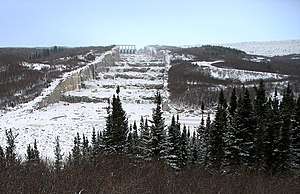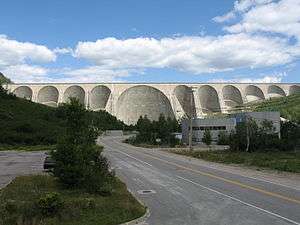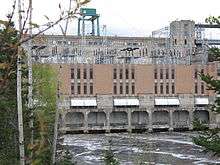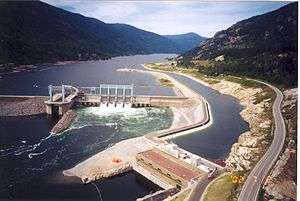Hydroelectricity in Canada
Canada is the world's third largest producer of hydroelectricity after China and Brazil.[1] In 2014, Canada consumed the equivalent of 85.7 megatonnes worth of oil of hydroelectricity, 9.8% of worldwide hydroelectric consumption. Furthermore, hydroelectricity accounted for 25.7% of Canada's total energy consumption (37.3% of non-oil sources). It is the third-most consumed energy in Canada behind oil and natural gas (30.9% and 28.1% of total consumption, respectively).[2]
| Electricity generation in Canada |
|---|
 |
Some provinces and territories, such as British Columbia, Manitoba, Newfoundland and Labrador, Quebec and Yukon produce over 90% of their electricity from Hydro. All of the dams with large reservoirs were completed before 1990, since then most development has been run-of-the-river, both large and small. Natural Resources Canada calculates the current installed small hydro capacity is 3,400 MW, with an estimated potential of 15,000 MW.[3] A report on the future of hydroelectricity, suggests the remaining 78% potential will remain undeveloped up to 2050, citing a lack of public acceptance.[4] The widespread usage of hydroelectricity, including being incorporated into electric utility names such as Toronto Hydro or BC Hydro, has led to "hydro" being used in some parts of Canada to refer to electricity in general, regardless of source.[5][6]
Canada has 81 GW of installed hydroelectric capacity, producing 400 TWh of electricity in 2019.[7]
By region
| province/territory | installed capacity (MW) |
|---|---|
| Alberta | 943 |
| British Columbia | 14,210 |
| Manitoba | 5,701 |
| Newfoundland and Labrador | 7,775.8 |
| New Brunswick | 950.1 |
| Northwest Territories | 56 |
| Nova Scotia | 365 |
| Ontario | 7,480 |
| Prince Edward Island | 0 |
| Quebec | 38,400 |
| Saskatchewan | 868 |
| Yukon | 95 |
British Columbia
BC Hydro owns and operates the majority of hydroelectric installations in British Columbia. A second crown corporation, Columbia Power Corporation and two companies also own large dams in BC, Alcan's Kemano Project and FortisBC.
90% of BC Hydro's generation is produced by hydroelectric means. Natural gas and biomass thermal power round out the generation portfolio.[9]
Over 80% of BC Hydro's installed in generating capacity is at hydroelectric installations in the Peace and Columbia river basins. The GM Shrum and Peace Canyon generating stations are on the Peace River produced 29% of BC Hydro's electricity requirements. In the Columbia River Basin, Mica and Revelstoke hydroelectric plants together contributed 25%, while Kootenay Canal and Seven Mile generating stations together supplied 10%.[10]
The remaining 25 hydroelectric generating stations supplied 14% of electricity production. BC Hydro also operates thermal power plants. The Burrard Thermal Generating Station contributes 7.5% and the remaining 14.5% of the electricity requirement was supplied by purchases and other transactions.[10]
BC Hydro's last dam was completed in 1984, since then run-of-the-river projects with private partners have been built. Power production without reservoirs varies dramatically through the year, so older dams with large reservoirs, retain water and average out capacity. As of 2012, there were approximately 40 small hydro sites generating 750 MW.[11] By 2014 various companies have built a total of 100 run of the river projects under 50 MW. In 2014 they produced 18,000 GWh from 4,500 MW of capacity.[12]
Manitoba Hydro
As of March 31, 2018, Manitoba Hydro serves a peak Manitoba electrical load of 5,648 megawatts.[13] Electrical supply to Manitoba customers was 22.5 terawatt-hours in fiscal 2017, with total revenue due to electricity of $1.464 billion CAD. Extraprovincial sales totaled $437 million in 2017-18 and were at 9.448 terawatt-hours, with normal water flows.[14] The company also delivered 2.048 billion cubic metres of natural gas in 2017–18, which contributed $346 million CAD to revenues.[15] As of early 2020, around 97% of the electricity generation in Manitoba comes from hydroelectricity.[16]
Newfoundland and Labrador
Newfoundland and Labrador Hydro's installed generating capacity, 7289 megawatts (MW), 92 percent hydroelectric, is the fourth largest of all utility companies in Canada.
Northwest Territories
The Northwest Territories has an installed hydroelectric generating capacity of 55 MW, supplying electricity to the North Slave and South Slave electricity grids. Each grid operates independently and is not connected to the electrical grid in the rest of Canada.
Ontario
Ontario Power Generation Produces 50% of the electricity used in the province, 40% from hydroelectric, and 60% from nuclear-powered facilities. They're also thermal plants that burn biomass and natural gas with a generating capacity of 2,458 MW; these plants were not used in 2015.[17]
After a provincial government commitment to phase out all coal generating plants, two units at Nanticoke were shut down in fall 2010.[18] Another two were shut down in 2011.[19] The final four were shut down on December 31, 2013.[20]
Quebec
Hydro-Québec's extensive network of 61 hydroelectric dams have a combined capacity of 38,400 megawatts,[21] accounting for over half of the Canadian total. Hydropower accounts for 95.73%[22] of the supply sold by the Quebec state-owned utility. Five of Hydro-Québec's hydroelectric facilities are rated above 2,000 MW — the Manic-5, La Grande-4, La Grande-3 La Grande-2-A and Robert-Bourassa stations — while 7 others have a capacity of over 1,000 megawatts.[23]
New projects
The Lower Churchill Project is a planned hydroelectric project in Labrador and includes the Muskrat Falls Generation Facility with a total generating capacity of 824 MW in 2021. The proposed Gull Island facility would consist of a generation station with a capacity of 2,250 MW after 2023.[24]
Romaine River project in Quebec started construction in 2009 and will have a capacity of 1550 MW by 2020.
Site C dam on the Peace River in British Columbia will have a capacity of 1100 MW in 2024.
Keeyask on the Nelson River, Manitoba is under construction and expecting completion of a 695 MW station in 2021.[25]
International comparison
| Population (thousands) | Area (km2) | Renewable freshwater resources | Total water withdrawal (km3) per year | Gross Domestic Product (millions of $ U.S.) | Gross Domestic Product ($ U.S.) per capita | ||||
|---|---|---|---|---|---|---|---|---|---|
| Volume (km3) | Volume (m3) per capita | Volume (m3) per unit area (m2) | |||||||
| Brazil | 188,158 | 8,514,880 | 8,233 | 1 | 43,756 | 0.967 | 59.3 | 1,089,398 | 5,790 |
| India | 1,147,746 | 3,287,260 | 1,892 | 9 | 1,648 | 0.576 | 645.9 | 911,376 | 794 |
| France | 63,236 | 549,190 | 204 | 43 | 3,226 | 0.371 | 40.0 | 2,266,137 | 35,836 |
| Canada | 32,628 | 9,978,904 | 3,472 | 3 | 1109,837 | 0.348 | 42.0 | 1,278,682 | 39,189 |
| United States | 305,697 | 9,632,030 | 3,051 | 4 | 9,980 | 0.317 | 473.6 | 13,116,500 | 42,907 |
| China | 1,297,847 | 9,598,090 | 2,830 | 6 | 2,181 | 0.295 | 630.4 | 2,779,871 | 2,142 |
| Russian Federation | 142,530 | 17,098,240 | 4,508 | 2 | 31,628 | 0.264 | 66.2 | 989,428 | 6,942 |
| Mexico | 106,411 | 1,964,380 | 457 | 25 | 4,295 | 0.233 | 78.2 | 945,644 | 8,887 |
| Australia | 20,628 | 7,741,220 | 492 | 21 | 23,851 | 0.064 | 23.9 | 787,418 | 38,172 |
| South Africa | 48,639 | 1,219,090 | 50 | 95 | 1,028 | 0.041 | 12.5 | 257,728 | 5,299 |
Gallery
 The Robert-Bourassa (LG-2) spillway, on Quebec's La Grande River.
The Robert-Bourassa (LG-2) spillway, on Quebec's La Grande River. Inside the Robert-Bourassa generating station powerhouse, the largest in North America with an installed capacity of 5,616 MW.
Inside the Robert-Bourassa generating station powerhouse, the largest in North America with an installed capacity of 5,616 MW. The Daniel-Johnson Dam, on Quebec's Manicouagan River (1968)
The Daniel-Johnson Dam, on Quebec's Manicouagan River (1968) The 230-MW Rocher-de-Grand-Mère station, on Quebec's Saint-Maurice River (2004)
The 230-MW Rocher-de-Grand-Mère station, on Quebec's Saint-Maurice River (2004) The 204-MW Rapide-Blanc generating station, on Quebec's Saint-Maurice River (1934)
The 204-MW Rapide-Blanc generating station, on Quebec's Saint-Maurice River (1934) A hydroelectric dam on the Arrow Lakes in British Columbia.
A hydroelectric dam on the Arrow Lakes in British Columbia.
See also
- List of electrical generating stations in Canada
- Renewable energy in Canada
- Wind power in Canada
- Solar power in Canada
- Geothermal power in Canada
- Renewable energy by country
References
- "Hydropower generation worldwide by leading country 2018". Statista. Retrieved 2020-04-13.
- "BP Statistical Review of World Energy June 2015" (PDF). BP Global. BP. pp. 36, 41. Retrieved 8 May 2016.
- https://www.nrcan.gc.ca/energy/renewable-electricity/small-hydropower/7363
- http://www.iea.org/publications/freepublications/publication/hydropower_essentials.pdf Archived 2017-03-29 at the Wayback Machine graph pg3
- Beam, Alex (August 21, 1996). "Eh? The Oxford Dictionary of Canadian English". Slate. Retrieved September 17, 2018.
Even though Canadians cheerfully use nuclear power and don't whine about it, they talk of paying the 'hydro' (electricity) bill.
- Laux, Sara (June 12, 2017). "7 words you'll only hear in Canada". Cottage Life. Blue Ant Media. Retrieved September 17, 2018.
In many parts of Canada, 'hydro' refers to electricity
- http://www.hydropower.org/publications/2020-hydropower-status-report pg45
- "About Renewable Energy". Natural Resources Canada. 13 December 2017. Retrieved 6 July 2019.
- "Generation System". BC Hydro. Archived from the original on May 3, 2012. Retrieved January 19, 2020.
- ergy_in_bc/our_system/generation.html BC Hydro Generation System Retrieved 2012-03-05
- http://www.energybc.ca/profiles/runofriver.html#rorworld
- "Archived copy". Archived from the original on 2016-02-06. Retrieved 2016-02-06.CS1 maint: archived copy as title (link)
- "Manitoba Hydro Annual Report 2017–18". www.hydro.mb.ca. Retrieved 2019-03-21.
- "Manitoba Hydro Annual Report 2017–18" (PDF). www.hydro.mb.ca. p. 34. Retrieved 2019-03-21.
- "Manitoba Hydro Annual Report 2017–18" (PDF). www.hydro.mb.ca. p. 27,42. Retrieved 2019-03-21.
- "The Main Electricity Sources in Canada by Province". EnergyRates.ca. 2018-11-30. Retrieved 2020-05-06.
- http://www.opg.com/generating-power/Pages/generating-power.aspx
- Talaga, Tanya (3 September 2009). "Ontario shuts 4 coal-fired units". The Star. Toronto.
- "Ontario's Long-Term Energy Plan" (PDF). Government of Ontario. 2010. Archived from the original (PDF) on 4 September 2012. Retrieved 22 August 2012.
- "OPG'S NANTICOKE STATION STOPS BURNING COAL" (PDF). Ontario Power Generation. 2014. Archived from the original (PDF) on 2014-01-16. Retrieved 18 April 2014.
- "Facts - Canadian Hydropower. Electricity that is clean, renewable and reliable". Canadian Hydropower. Electricity that is clean, renewable and reliable. Retrieved 2016-04-07.
- Hydro-Québec (2007). "Hydro-Québe's Electricity Facts: Energy Supplies and Air Emissions" (PDF). Archived from the original (pdf) on 2010-08-27. Retrieved 2009-05-06.
- Hydro-Québec. Hydro Quebec: Annual Report, 2013 (pdf). Montreal.
- https://nalcorenergy.com/nalcor-operations/lower-churchill-project/
- http://www.hydro.mb.ca/projects/keeyask/
- Canadian Government. "Renewable freshwater resources, water use and gross domestic product for selected countries". Statistics Canada.
External links
Further reading
- Desbiens, Caroline. Power from the North: Territory, Identity, and the Culture of Hydroelectricity in Quebec (2014)
- Froschauer, Karl. White gold: Hydroelectric Power in Canada. (Vancouver: UBC Press, 1999) excerpt and text search